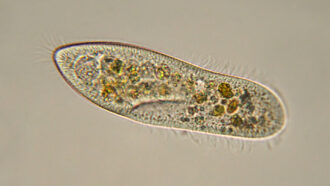Fast-flying fungal spores
Using high-speed cameras, scientists identify the fastest spores on Earth.
 |
|
Filming a fungus at 250,000 frames per second, a research team could watch in slow-motion a process that usually takes a few millionths of a second: the fungus catapulting a spore as far out as possible. View a video of the spores being lau |
| Yafetto, L. et al / PLoS ONE |
Life’s not easy for fungi that live on piles of animal waste, or dung. For starters, well, they’re living in dung. And to complete their life cycle, fungi release cells called spores that must be eaten by an animal so that a new generation can emerge. The trouble is, not too many animals want to eat dung or the plants growing near it.
Dung-dwelling fungi have evolved a way to get around this challenge: They shoot their spores at high speed as far as two-and-a-half meters away, increasing the odds that a hungry herbivore will eat them.
Scientists have been curious about fungal spore-flinging abilities for hundreds of years. The process happens so quickly — in 1/400th the time it takes for you to blink your eye — that nobody has been able to watch all the steps in the process or calculate the speed at which the spores fly. Now, a team of scientists has used high-speed video cameras to watch the lightning-fast process in slow motion.
By using a camera that captures 250,000 frames per second, the researchers were able to watch how the fungus shoots out its spores like a miniature squirt gun. The team was also able to measure the speed at which the spores launch from the fungus. They found that spores fly from the main fungal body at an initial speed of 25 meters per second, or 55 miles per hour. To reach that speed from a standstill, the spores accelerate even more than the acceleration astronauts feel at liftoff (close to 200,000 g). According to the researchers, these spores experience the fastest acceleration known in nature.
Fungi are a group of living things that are neither plants nor animals. Molds, yeasts and mushrooms are all types of fungi, most of which produce spores. Fungal spores, and especially mold spores, can cause problems ranging from seasonal allergies to serious illnesses in people, livestock, pets and crops. Understanding how spores fly may help scientists better predict and control how these spores travel, the researchers say.
Fast-flying fungal spores from Science News on Vimeo.
Going Deeper:







